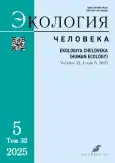Возможности использования направленных ациклических графов при планировании и интерпретации результатов биомедицинских исследований
- Авторы: Кригер Е.А.1, Постоев В.А.1, Кудрявцев А.В.1, Унгуряну Т.Н.1, Гржибовский А.М.1,2,3
-
Учреждения:
- Северный государственный медицинский университет
- Северо-Восточный федеральный университет им. М.К. Аммосова
- Северный (Арктический) федеральный университет им. М.В. Ломоносова
- Выпуск: Том 32, № 5 (2025)
- Страницы: 300-314
- Раздел: ОБЗОРЫ
- URL: https://journal-vniispk.ru/1728-0869/article/view/314590
- DOI: https://doi.org/10.17816/humeco683466
- EDN: https://elibrary.ru/MXPLRC
- ID: 314590
Цитировать
Полный текст
Аннотация
В статье представлен алгоритм построения и применения направленных ациклических графов (Directed Acyclic Graphs, DAGs) при планировании эпидемиологических и биомедицинских исследований. DAGs представляют собой графический инструмент для моделирования сложных связей между переменными, что особенно актуально в биомедицинской науке, где корректная оценка причинно-следственных связей требует учёта потенциальных вмешивающихся факторов. Подчёркивается значимость DAGs для концептуализации научной гипотезы и понимания структуры связей между факторами на основе анализа литературы и результатов ранее проведённых исследований. Применение DAGs способствует повышению качества как планирования исследования, так и анализа данных, обеспечивая более обоснованный подход к отбору переменных для включения в математические модели. DAGs позволяют определить минимальный и достаточный набор факторов для коррекции с учётом роли переменных (конфаундеров, медиаторов, коллайдеров) относительно воздействия (вероятного фактора риска) и исхода (заболевания или состояния), тем самым снижая риск аналитических ошибок. В статье акцентируется внимание на практическом применении DAGs с помощью доступного программного обеспечения, а также представлены конкретные примеры использования графов в биомедицинских исследованиях. В заключение предложены рекомендации по интеграции DAGs в практику биомедицинских исследований, что может способствовать более широкому внедрению современных методов многомерного статистического анализа, улучшению интерпретируемости и повышению воспроизводимости научных результатов.
Полный текст
Открыть статью на сайте журналаОб авторах
Екатерина Анатольевна Кригер
Северный государственный медицинский университет
Email: kate-krieger@mail.ru
ORCID iD: 0000-0001-5179-5737
SPIN-код: 2686-7226
канд. мед. наук, PhD, доцент
Россия, АрхангельскВиталий Александрович Постоев
Северный государственный медицинский университет
Email: ispha@nsmu.ru
ORCID iD: 0000-0003-4982-4169
SPIN-код: 6070-2486
канд. мед. наук, PhD, доцент
Россия, АрхангельскАлександр Валерьевич Кудрявцев
Северный государственный медицинский университет
Email: ispha09@gmail.com
ORCID iD: 0000-0001-8902-8947
SPIN-код: 9296-2930
PhD
Россия, АрхангельскТатьяна Николаевна Унгуряну
Северный государственный медицинский университет
Email: unguryanu_tn@mail.ru
ORCID iD: 0000-0001-8936-7324
SPIN-код: 7358-1674
д-р мед. наук, PhD, доцент
Россия, АрхангельскАндрей Мечиславович Гржибовский
Северный государственный медицинский университет; Северо-Восточный федеральный университет им. М.К. Аммосова; Северный (Арктический) федеральный университет им. М.В. Ломоносова
Автор, ответственный за переписку.
Email: andrej.grjibovski@gmail.com
ORCID iD: 0000-0002-5464-0498
SPIN-код: 5118-0081
доктор медицины, PhD
Россия, Архангельск; Якутск; АрхангельскСписок литературы
- Mitkin NA, Drachev SN, Krieger EA, et al. Sample size calculation for cross-sectional studies. Ekologiya cheloveka (Human Ecology). 2023;30(7):509–522. doi: 10.17816/humeco569406 EDN: LOEJVM
- Greenland S, Pearl J, Robins JM. Causal diagrams for epidemiologic research. Epidemiology. 1999;10(1):37–48.
- Shrier I, Platt RW. Reducing bias through directed acyclic graphs. BMC Med Res Methodol. 2008;8:70. doi: 10.1186/1471-2288-8-70
- VanderWeele TJ. Principles of confounder selection. Eur J Epidemiol. 2019;34(3):211–219. doi: 10.1007/s10654-019-00494-6
- Foraita R, Spallek J, Zeeb H. Directed acyclic graphs. In: Ahrens W, Pigeot I, editors. Handbook of Epidemiology. New York: Springer; 2014. P. 1481–1517. doi: 10.1007/978-0-387-09834-0_65
- Kornaropoulos EM, Tollis IG, DAG View: an approach for visualizing large graphs. In: Didimo W, Patrignani M, editors. Graph Drawing. GD 2012. Lecture Notes in Computer Science. Vol. 7704. Berlin, Germany: Springer; 2013. P. 499–510. doi: 10.1007/978-3-642-36763-2_44
- Textor J, Zander BVD, Gilthorpe MS, et al. Robust causal inference using directed acyclic graphs: the R package ‘dagitty’. Int J Epidemiol. 2016;45(6):1887–1894. doi: 10.1093/ije/dyw341
- Porta MS, Greenland S, Hernánet M, et al. A dictionary of epidemiology. 6th ed. New York: Oxford University Press; 2014. 343 p.
- Szklo M, Nieto FJ. Epidemiology: Beyond the Basics. 4th ed. Sudbury: Jones & Bartlett Learning, LLC; 2018. 489 p.
- Bursac Z, Gauss CH, Williams DK, et al. Purposeful selection of variables in logistic regression. Source Code Biol Med. 2008;3:17. doi: 10.1186/1751-0473-3-17
- Textor J, Liśkiewicz M. Adjustment criteria in causal diagrams: an algorithmic perspective. In: Proceedings of the Twenty-Seventh Conference on Uncertainty in Artificial Intelligence. Barcelona, Spain: AUAI Press; 2011. doi: 10.48550/arXiv.1202.3764
- Lee PH. Is a cutoff of 10% appropriate for the change-in-estimate criterion of confounder identification? J Epidemiol. 2014;24(2):161–167. doi: 10.2188/jea.je20130062
- Heinze G, Wallisch C, Dunkler D. Variable selection — A review and recommendations for the practicing statistician. Biom J. 2018;60(3):431–449. doi: 10.1002/bimj.201700067
- Bailey LC, Forrest CB, Zhang P, et al. Association of antibiotics in infancy with early childhood obesity. JAMA Pediatr. 2014;168(11):1063–1069. doi: 10.1001/jamapediatrics.2014.1539
- Li DK, Chen H, Ferber J, et al. Infection and antibiotic use in infancy and risk of childhood obesity: a longitudinal birth cohort study. Lancet Diabetes Endocrinol. 2017;5(1):18–25. doi: 10.1016/S2213-8587(16)30281-9
- Dekkers OM, Laugesen K, Groenwold RHH. Directed acyclic graphs in clinical research. Eur J Endocrinol. 2024;190(4):E5–E7.
- Williamson EJ, Walker AJ, Bhaskaran K, et al. Factors associated with COVID-19-related death using OpenSAFELY. Nature. 2020;584(7821):430–436. doi: 10.1038/s41586-020-2521-4
- Sattar N, McInnes IB, McMurray JJV. Obesity is a risk factor for severe COVID-19 infection: multiple potential mechanisms. Circulation. 2020;142(1):4–6. doi: 10.1161/CIRCULATIONAHA.120.047659
- Hamer M, Kivimäki M, Gale CR, Batty GD. Lifestyle risk factors, inflammatory mechanisms, and COVID-19 hospitalization: A community-based cohort study of 387,109 adults in UK. Brain Behav Immun. 2020;87:184–187. doi: 10.1016/j.bbi.2020.05.059
- Fang L, Karakiulakis G, Roth M. Are patients with hypertension and diabetes mellitus at increased risk for COVID-19 infection? Lancet Respir Med. 2020;8(4):e21. doi: 10.1016/S2213-2600(20)30116-8
- Griffith GJ, Morris TT, Tudball MJ, et al. Collider bias undermines our understanding of COVID-19 disease risk and severity. Nat Commun. 2020;11(1):5749. doi: 10.1038/s41467-020-19478-2
- Lash MP, Fink AK. Applying quantitative bias analysis to epidemiologic data. New York: Springer; 2011. 192 р.
Дополнительные файлы














